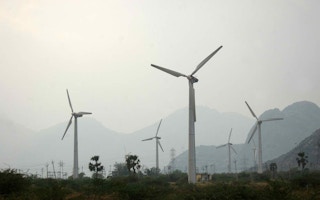With a tenfold increase in its allocation, the Ministry of New and Renewable Energy (MNRE) has come out smiling after Arun Jaitley, India’s Finance Minister, presented the country’s annual budget on February 29.
The ministry will now have Rs 5,036 crore (USD 738 million), a huge hump from its 2014-15 allocation of Rs 515 crore.
The other big news on the environment front is a doubling of the coal tax from Rs 200 to Rs 400 per tonne (USD 3-6). While all green groups welcomed that, some were worried about where the money would go.
So far, the money has been going to the National Clean Energy Fund, which already has around Rs 17,000 crore and 56 projects recommended to it by various ministries. It has allocated Rs 4,700 crore in 2015-16.
Now, this will be renamed the National Clean Environment Fund (NCEF), and that is where the coal tax will go.
Srinivas Krishnaswamy of the New Delhi-based think tank the Vasudha Foundation said, “This is scary as they are suddenly increasing the ambit of the fund. It can be used now for cleaning of river systems, pollution etc. In any case a lot of money is going down the drain in cleaning rivers.” Tackling air, water and soil pollution definitely needs more money, but taking it out of this fund may leave too little to handle impacts of climate change.
Anumita Roychowdhury of the New Delhi-based think tank Centre for Science and Environment pointed out that till August 2015, not a single rupee was disbursed by the NCEF for renewable energy projects. “This fund should be used for renewable energy, clean coal technology and pollution control for power plants,” she said. “The doubling of cess [tax] demands clear protocol for spending for effective results.”
The Ministry Of Water Resources, River Development and Ganga Rejuvenation has got a slightly higher allocation, from Rs 5,480 crore to Rs 6,201 crore. But it had ended up spending more last year: Rs 7,032 crore.
In addition, the Finance Minister said the government had prepared “a major programme for sustainable management of ground water resources”. This will cost an estimated Rs 6,000 crore and the government is looking for multilateral funding.
LPG expansion welcome
All green groups lauded the move to expand LPG (liquefied petroleum gas) connection among rural poor. The budget aims to cover 15 million households that are below poverty line in 2016-17 and 50 million more in the next two years so that there is universal coverage of cooking gas.
Welcoming the move, Roychowdhury pointed out that indoor air pollution is the second largest killer in India.
The Finance Minister has levied a tax on cars to tackle outdoor air pollution. He said in parliament, “The pollution and traffic situation in Indian cities is a matter of concern. I propose to levy an infrastructure cess [tax], of 1 per cent on small petrol, LPG, CNG cars, 2.5 per cent on diesel cars of certain capacity and 4 per cent on other higher engine capacity vehicles and SUVs.”
Krishnaswamy described this levy as “minuscule” and “not enough to act as a deterrent from using cars.”
Renewable industry happy, but not quite
The renewable energy industry was happy with the overall thrust of the budget but found quite a few devils in the details. Tulsi Tanti, head of wind turbine manufacturer Suzlon, said, “On renewable energy specifically, as part of rural development, the government continues its plan to provide 100 per cent electrification by 1st May, 2018. This poses incredible opportunity for the renewable sector and to boost rural economy.”
However, Tanti called for further duty reductions on imported parts used in the manufacturing of rotor blades and other taxe breaks to encourage the wind industry in line with the government target of 175 GW renewables by 2022 and to boost manufacturing under the Make in India vision.
Boost for rural poor
The budget also aims to boost growth in rural areas. Vineet Mittal, Vice Chairman of Welspun Renewables, said, “Multiple schemes like 100 per cent village electrification by 2018, Rs 38,500 crore for MGNREGS (Mahatma Gandhi National Rural Employment Guarantee Scheme), the highest ever, and LPG subsidy for rural women — all these initiatives were much-needed.”
While welcoming the MGNREGS allocation and a new crop insurance policy that was announced in the Budget, Roychowdhury said, “These programmes are still underfunded compared to what is needed today.
The Finance Minister said MGNREGS would take up the job of digging 500,000 ponds and wells in areas without irrigation facilities. The scheme also includes digging a million compost pits for production of organic manure.
Reacting to the Budget, Prakash Javadekar, India’s environment minister, did not refer to any specific green initiative. He said, “This budget is completely devoted to the upliftment of the poor, rural development, welfare of farmers and empowerment of the poor.”










